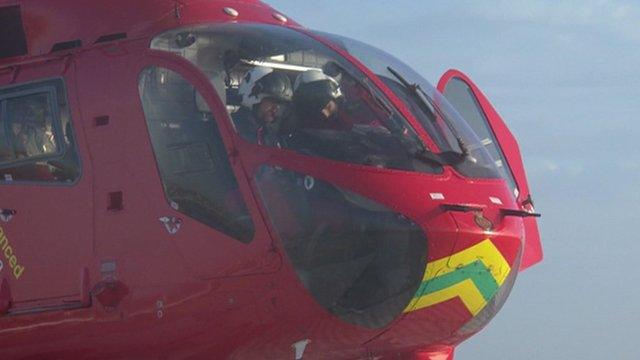Balloon surgery stops fatal bleeding at roadside
- Published
London's Air Ambulance aim to bring the emergency department to the roadside
London's Air Ambulance crew have become the first team in the world to use a balloon device to control catastrophic bleeding at the roadside.
They hope technique will also help prevent deaths and disability from road collisions and falls from height.
The small balloon is inflated inside major blood vessels to stop internal blood loss - a common cause of death after severe injuries.
This may be a "major advance" in trauma care outside hospitals, experts say.
The technique, known as Reboa (resuscitative endovascular balloon occlusion of the aorta), was first used in the UK by the Royal London Hospital.
And after two years of further development, the London's Air Ambulance charity have used it to treat a patient who suffered severe pelvic injuries and bleeding.
'Inflated balloon'
Pedestrians or cyclists involved in serious crashes often have internal bleeding due to injury to blood vessels deep inside the body - these cannot be compressed from the outside.
But this technique allows doctors to gain access quickly and control bleeding from within.
When the pelvis is injured - for example - large vessels in that area can be torn, leading to massive blood loss.
And some people will die at the scene or before they can be transferred safely to hospital.
Dr Gareth Davies, medical director at London's Air Ambulance and emergency medicine consultant at Barts Health NHS Trust, said: "We believe the use of Reboa can lead to a reduction in the number of patients who quite simply bleed to death before they have the chance to get to hospital."
How the device is used:

The device is fed into the main artery and the balloon is inflated
The device is made of a thin plastic tube with a balloon at the tip.
Using a series of guide wires, the tube is fed, through a vessel in the leg, into the lower part of the aorta - the major blood vessel in the body.
And once in the correct position it can then be inflated using a small amount of liquid, temporarily cutting off blood supply to the damaged blood vessels.
Buying time
This can buy doctors and paramedics valuable time to get the patient to the nearest hospital where further surgery may be carried out.
Mr David Nott, a surgeon at St Mary's Hospital, London, who was not involved in this work, said: "This is a fantastic idea.
"Stopping the bleeding as soon as possible has to be the way forward, and this balloon may help stop it almost immediately.
"Obviously this is new for pre-hospital care - it will have to be used by people experienced and trained in trauma care.
"It could be a major advance in the treatment of trauma."
Prof Karim Brohi, at Barts Health NHS Trust ,who was involved in developing the roadside technique, said: "Over 2.5 million people bleed to death from their injuries each year around the world.
"We have to stop people bleeding to death - it's one of the world's biggest killers.
"And while Reboa sounds relatively simple, it is an extremely difficult technology to deliver in an emergency department in hospital, never mind at the roadside."
- Published5 March 2012
- Published9 January 2014
